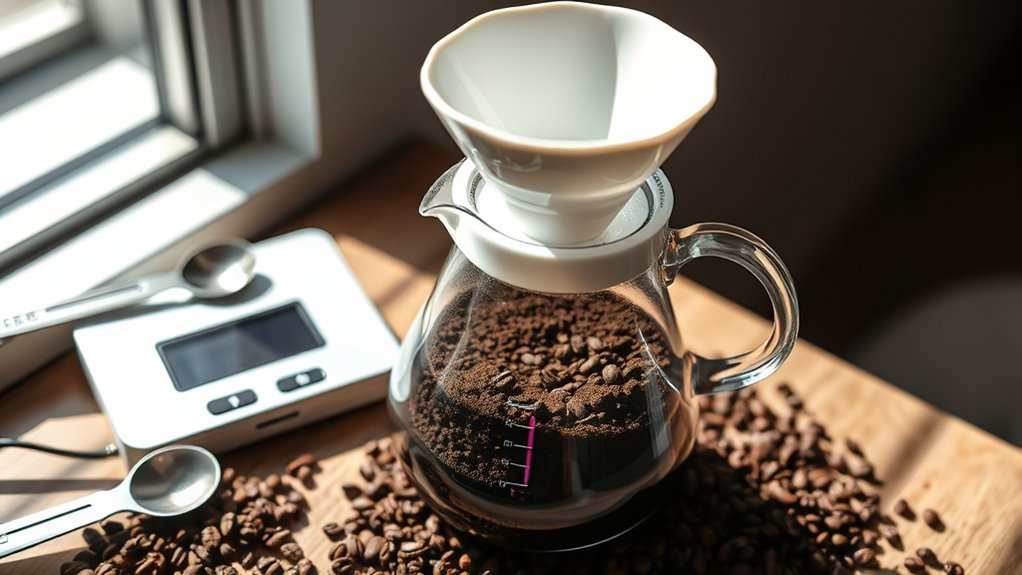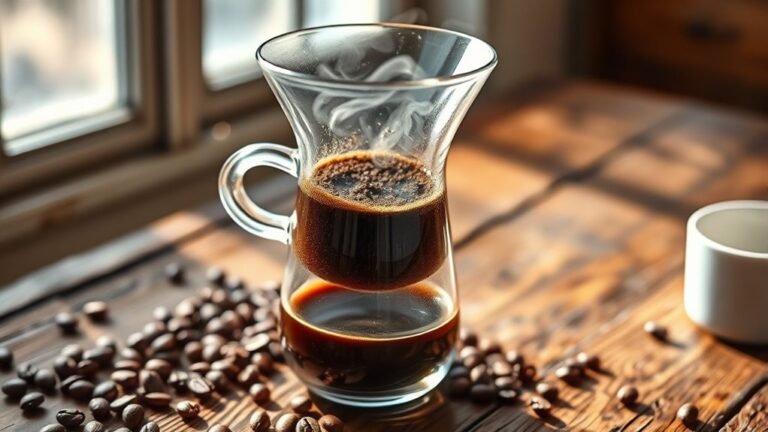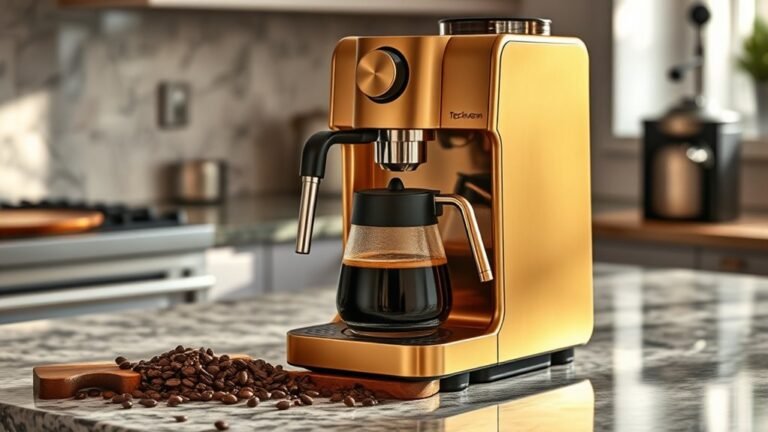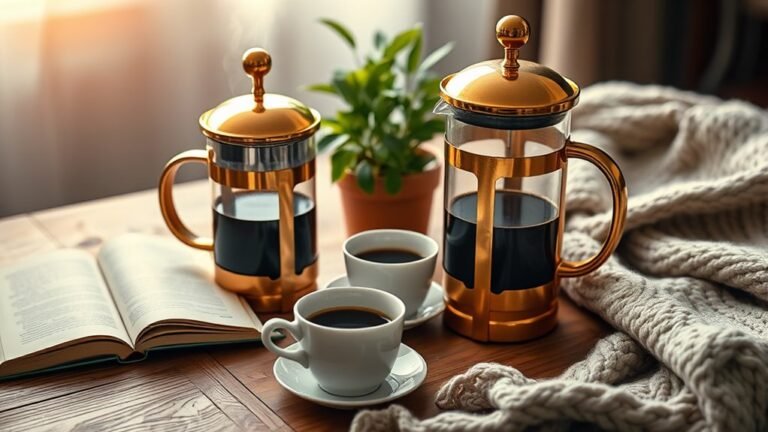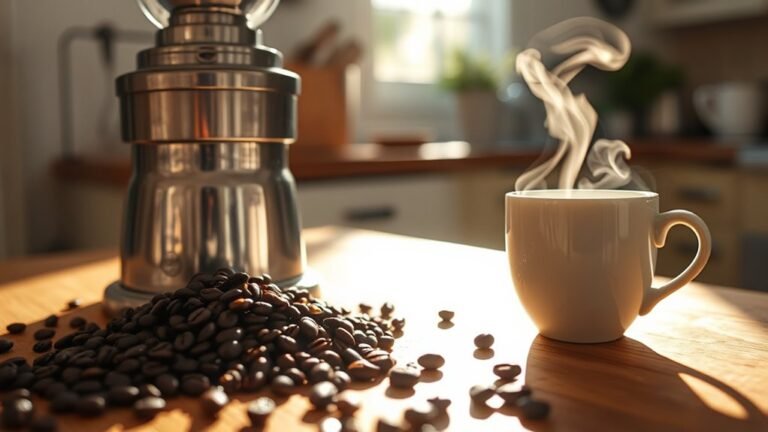Exploring Different Coffee Brewing Ratios
When exploring different coffee brewing ratios, you’ll find that adjusting the coffee-to-water balance directly shapes your brew’s flavor—too much water weakens it, too little makes it bitter. Common methods have standard ratios: drip coffee around 1:16, espresso about 1:2, and French press near 1:15. Water temperature and grind size also influence extraction, so tweaking these alongside ratios deepens your control. Fine-tuning these elements can transform your daily cup into a personal masterpiece; more insights await to guide your journey.
Understanding Coffee-to-Water Ratios
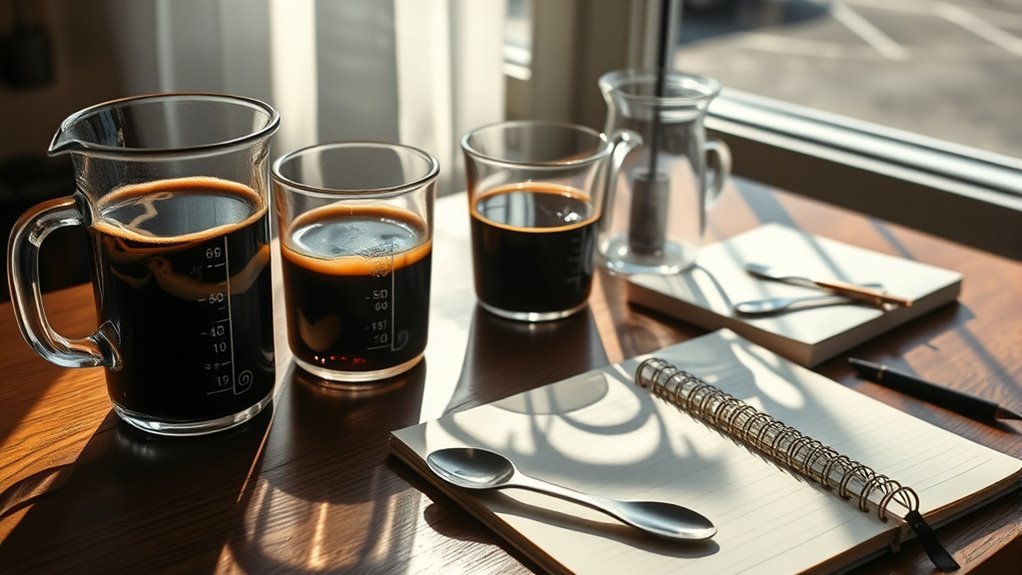
Although it might seem straightforward, understanding coffee-to-water ratios is essential for brewing a cup that truly satisfies your taste buds. You hold the power to reveal nuanced coffee flavor by mastering this balance. Too much water dilutes the essence; too little leaves bitterness. Each brewing technique—whether pour-over, French press, or espresso—demands a tailored ratio to extract prime flavor. Embracing these ratios lets you craft coffee that aligns with your personal freedom to experiment and refine. Instead of following rigid rules, use ratios as a foundation to explore, adjusting strength and clarity until the brew resonates with your palate. By grasping this concept, you claim control over every cup, making your coffee ritual an expression of your unique taste.
Standard Ratios for Drip Coffee
When brewing drip coffee, you’ll want to start with the standard ratio of about 1:16—one part coffee to sixteen parts water—to achieve balanced flavor. You can easily adjust this ratio to suit your strength preference, whether you like it bolder or lighter. Understanding these water-to-coffee measurements guarantees your brew stays consistent and delicious every time.
Common Drip Coffee Ratios
One of the most reliable ways to brew a great cup of drip coffee is by mastering the standard coffee-to-water ratios. Typically, a ratio of 1:15 to 1:17 (coffee to water) works best, meaning you use about 1 gram of coffee for every 15 to 17 grams of water. This range balances extraction and flavor, giving you a clean, vibrant cup. Your brewing equipment—whether a pour-over cone, automatic drip machine, or immersion brewer—affects how these ratios perform, so adapt accordingly. Practicing precise drip coffee techniques guarantees consistency and control, empowering you to reveal your preferred flavor profiles without guesswork. By understanding these common ratios, you gain the freedom to brew confidently, tailoring each cup to your taste while respecting the science behind every pour.
Adjusting Strength Preferences
Mastering the standard coffee-to-water ratios gives you a solid foundation, but adjusting those ratios lets you tailor your brew’s strength exactly how you like it. Your strength preferences directly influence the flavor profiles you experience, from a delicate brightness to a robust, bold character. Here’s a quick guide to customizing your drip coffee strength:
| Strength Level | Coffee-to-Water Ratio |
|---|---|
| Light | 1:18 |
| Medium | 1:16 |
| Strong | 1:14 |
| Very Strong | 1:12 |
| Ultra Bold | 1:10 |
Water-to-Coffee Measurements
Getting your water-to-coffee measurements right is essential for brewing a balanced and flavorful cup. Precise ratios guarantee you access your coffee’s true potential without overpowering or diluting its character. When you focus on water quality and use accurate measurement tools, you gain control over your brew’s consistency.
Here are standard ratios for drip coffee to guide your freedom in crafting the perfect cup:
- Start with a 1:16 coffee-to-water ratio (e.g., 20g coffee to 320ml water).
- Adjust between 1:15 for a stronger brew or 1:17 for a lighter one.
- Use a digital scale and a quality water source to maintain precision.
- Experiment with slight tweaks to find your ideal balance, honoring both coffee and water quality.
This approach empowers you to brew confidently every time.
Brewing Ratios for Espresso
When dialing in your espresso, understanding the brewing ratio—the weight of coffee grounds to the final shot volume—is essential. This ratio directly influences espresso extraction, affecting flavor balance and intensity. Typically, a 1:2 ratio is standard, meaning if you use 18 grams of coffee, your shot yield should be about 36 grams. However, you’re free to adjust this based on taste preferences and your brewing equipment’s capabilities. Precision scales and reliable espresso machines allow you to experiment confidently, ensuring consistent results. Mastering these ratios grants you control over body, acidity, and sweetness, releasing the freedom to craft espresso that resonates with your palate. Embrace the science behind each shot, and transform your espresso routine into an art form defined by deliberate, exact brewing.
Ratios for French Press Coffee
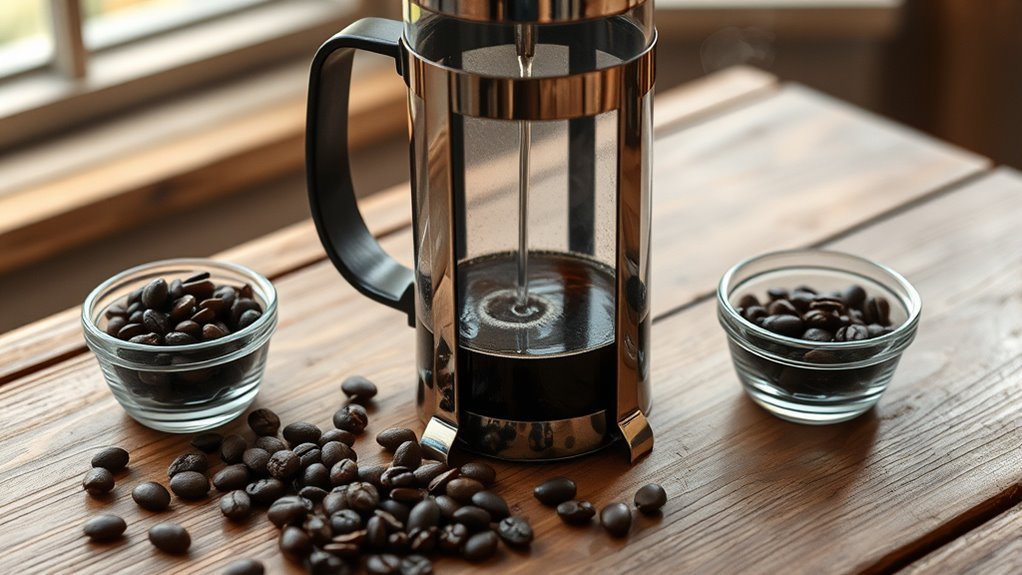
When brewing French press coffee, the ideal coffee-to-water ratio is typically around 1:15, giving you a balanced extraction and rich flavor. You can easily adjust this ratio to make your cup stronger or lighter, depending on your taste preferences. Mastering this ratio lets you reveal the full potential of your beans with every brew.
Ideal Coffee-to-Water Ratio
Achieving the ideal coffee-to-water ratio is essential for brewing a perfect French press cup that balances strength and flavor. When you master this ratio, you reveal the true potential of your coffee’s flavor profiles and elevate your brewing methods. Here’s a guide to get you started:
- Use a ratio of 1:15 (coffee to water) for a balanced, rich taste.
- For a bolder cup, try 1:12, enhancing intensity without bitterness.
- Start with 30 grams of coffee to 450 ml water for a standard 3-cup French press.
- Adjust grind size to coarse to complement the ratio and avoid over-extraction.
Adjusting Strength and Flavor
Mastering the ideal coffee-to-water ratio sets the foundation, but tweaking that ratio lets you tailor your French press brew to your exact taste preferences. By adjusting the coffee grounds, you gain control over strength balance and reveal new layers of flavor enhancement. Here’s a quick guide to help you experiment confidently:
| Coffee (grams) | Water (ml) |
|---|---|
| 15 | 250 |
| 18 | 250 |
| 20 | 250 |
| 22 | 250 |
| 25 | 250 |
Lower coffee amounts yield a lighter body and subtle flavor notes, while higher amounts produce a bolder, richer cup. Embrace this freedom to craft your perfect French press experience every time.
Adjusting Ratios for Pour-Over Brewing
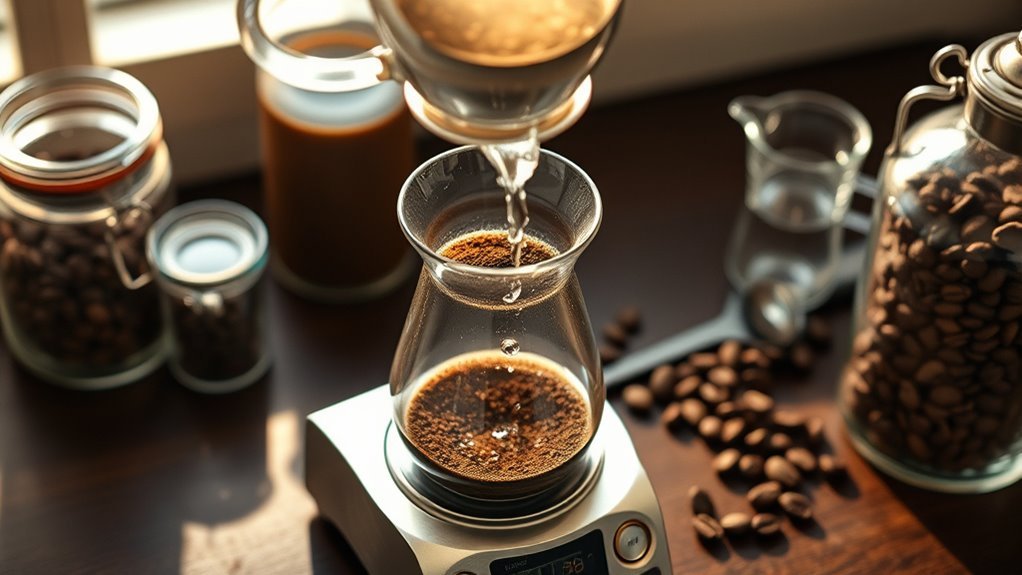
Although pour-over brewing is celebrated for its clarity and control, adjusting your coffee-to-water ratio can dramatically influence the final cup’s balance and flavor intensity. Mastering this lets you tailor your brew to your personal taste, revealing the full potential of your beans.
Consider these key points when tweaking ratios in pour over techniques:
- Start with a 1:16 coffee-to-water ratio for a balanced extraction.
- Increase coffee slightly (e.g., 1:15) to boost body and intensity.
- Use more water (e.g., 1:17) for a lighter, more delicate cup.
- Adjust grind size and pour speed to optimize flavor extraction alongside ratio changes.
Cold Brew Coffee Ratios
Two main ratios dominate cold brew coffee preparation, and understanding them will help you craft a smooth, rich concentrate or a ready-to-drink brew that suits your preference. For concentrate, a common ratio is 1:4 coffee to water, maximizing flavor extraction during the extended steeping time—usually 12 to 24 hours. If you prefer a ready-to-drink brew, a 1:8 ratio balances strength and smoothness. Using a coarse coffee grind enhances filtration and prevents over-extraction. Different brewing methods and coffee types influence your final cup, so experiment to find your ideal profile. For serving suggestions, dilute concentrate with water or milk. Store your cold brew in airtight containers, refrigerated up to two weeks, preserving freshness and flavor. Master these ratios to reveal cold brew’s full potential.
How Water Temperature Affects Brewing Ratios
Because water temperature directly influences extraction rates, adjusting your brewing ratios becomes essential to achieve the perfect balance of flavor. When you control water temperature, you’re directly affecting extraction efficiency, which in turn dictates how much flavor is drawn from the coffee grounds during your brew time. Here’s what you need to evaluate:
- Higher temperatures increase extraction efficiency, requiring a coarser grind or less coffee to avoid bitterness.
- Lower temperatures slow extraction, so you might need more coffee or a longer brew time to reach the desired strength.
- Water that’s too hot can over-extract, overpowering the cup with harsh flavors.
- Cooler water preserves delicate notes but demands precise ratio adjustments to maintain body and sweetness.
Mastering this balance empowers you to brew coffee that truly reflects your taste freedom.
Tips for Experimenting With Coffee Ratios
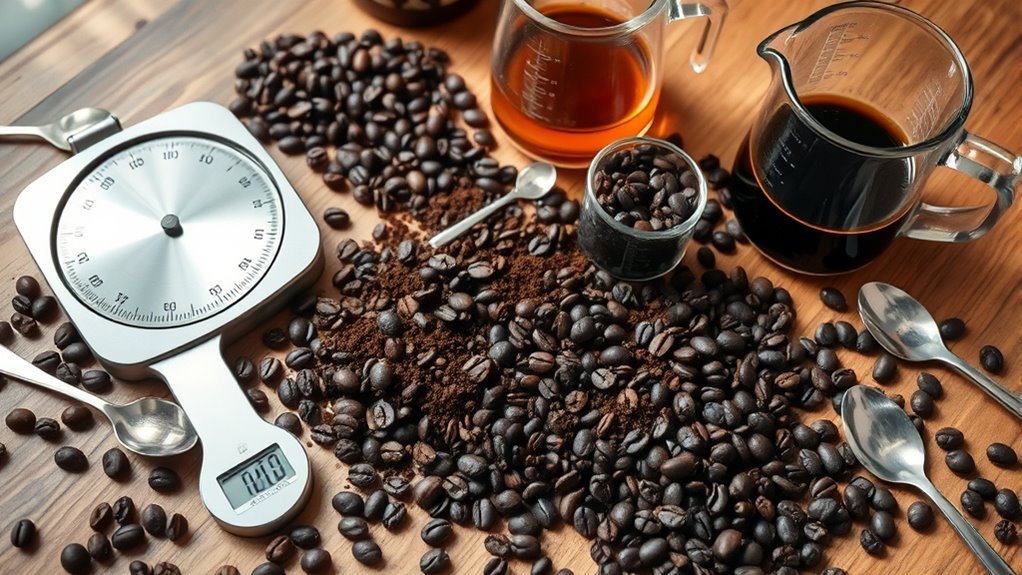
Adjusting your brewing ratios is a natural next step once you’ve considered how water temperature affects extraction. To truly reveal your coffee flavor, start by tweaking the coffee-to-water ratio incrementally—small changes reveal subtle shifts in taste. Keep detailed notes on each experiment, so you can identify which brewing techniques yield your preferred balance. Don’t hesitate to vary grind size alongside ratios; they work hand-in-hand to influence extraction. Embrace freedom by trusting your palate over rigid rules. Try different ratios for espresso, pour-over, or French press to discover what excites your taste buds. Remember, experimentation isn’t about perfection—it’s about exploring how ratios shape your daily cup. This approach lets you craft a brew that’s uniquely yours, enhancing every sip with intentionality and passion.
Frequently Asked Questions
How Does Grind Size Influence the Ideal Coffee-To-Water Ratio?
You’ll find grind adjustment essential because it directly impacts extraction balance. A finer grind increases surface area, speeding up extraction, so you’ll want to reduce your coffee-to-water ratio to avoid bitterness. Conversely, a coarser grind slows extraction, letting you use a higher ratio without under-extracting. By mastering grind size and ratio together, you gain freedom to craft coffee that perfectly suits your taste, revealing a truly personalized brew every time.
Can Altitude Affect Coffee Brewing Ratios?
You might think altitude effects are just minor nuisances, but they can turn your brewing world upside down! At higher elevations, water boils at lower temperatures, which seriously impacts brewing efficiency. This means you’ll need to tweak your coffee-to-water ratio to extract the perfect flavor. Don’t let altitude limit your freedom to craft amazing coffee—embrace these changes and experiment boldly to find your ideal balance!
What Equipment Is Best for Measuring Coffee-To-Water Ratios Precisely?
You’ll want digital scales for precision when measuring coffee-to-water ratios—they offer accuracy down to a gram, which measuring cups can’t match. Digital scales let you control your brew with exactness, freeing you from guesswork and ensuring consistency every time. While measuring cups are handy for rough estimates, only a good digital scale gives you the freedom to experiment confidently, dialing in your perfect cup with meticulous detail.
How Do Different Coffee Bean Origins Affect Brewing Ratios?
Imagine a Renaissance painter selecting colors—each stroke carefully chosen. Similarly, you adjust brewing ratios based on coffee bean origin flavors and brewing characteristics. Beans from Ethiopia, with bright, fruity notes, might need a lighter ratio to highlight delicacy, while Indonesian beans, rich and earthy, often call for a stronger brew. By tuning ratios, you reveal each origin’s unique essence, giving you freedom to craft a cup that’s truly yours.
Are There Health Benefits Linked to Specific Brewing Ratios?
You might be surprised to learn that brewing benefits extend beyond taste—your brewing ratio can influence health effects too. A stronger ratio often means higher antioxidants, which support your body’s defenses. However, too concentrated a brew could increase caffeine intake, impacting sleep or heart health. By adjusting your ratio, you control these effects, empowering your freedom to enjoy coffee that suits both your flavor preferences and well-being goals.
